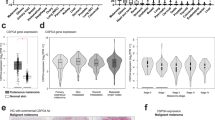Abstract
Heparan sulphate (HS) represents a heterogeneous class of molecules on cell membranes and extracellular matrices. These molecules are involved in a variety of biological processes, including immune responses, through their binding and functional modulation of proteins. Recently a panel of HS-epitope–specific, human single chain antibodies have been generated by phage display, facilitating analysis of the structural heterogeneity of HS in relation to pathological conditions. In a pilot study a heterogeneous staining pattern in melanoma metastases was observed with one of the clones (EW4G1). Using a double-staining technique, the expression of this epitope was studied in 12 metastatic melanoma lesions in relation to the presence of a CD3+ cell infiltrate. Different staining patterns with EW4G1 were observed in the different lesions. The different staining patterns were associated with the presence and pattern of inflammation with CD3+ cells. A pronounced staining pattern of blood vessels with EW4G1 was associated with a more or less brisk presence of CD3+ cells, while a pronounced staining of tumour cells or tumour cell matrix or absence of staining with EW4G1 was associated with absence of CD3+ cells. These results suggest a dualistic role for HS in the recruitment and intratumoural migration of CD3+ cells, depending on the location of expression of its epitope recognized by EW4G1. Further characterization of the structural diversity of HS and its function in T-cell recruitment and migration is therefore warranted, since detailed understanding of this relation may provide new targets for therapeutic intervention, such that better homing and migration of T cells (in)to tumours might be achieved in immunologically based treatment strategies.

Similar content being viewed by others
References
Caux F, Timar J, Lapis K, Moczar M (1990) Proteochondroitin sulphate in human melanoma cell cultures. Biochem Soc Trans 18:293
Ey PL, Prowse SJ, Jenkin CR (1978) Isolation of pure IgG1, IgG2a and IgG2b immunoglobulins from mouse serum using protein A-sepharose. Immunochemistry 15:429
Hershkoviz R, Schor H, Ariel A, Hecht I, Cohen IR, Lider O, Cahalon L (2000) Disaccharides generated from heparan sulphate or heparin modulate chemokine-induced T-cell adhesion to extracellular matrix. Immunology 99:87
Kato M, Wang H, Bernfield M, Gallagher JT, Turnbull JE (1994) Cell surface syndecan-1 on distinct cell types differs in fine structure and ligand binding of its heparan sulfate chains. J Biol Chem 269:18881
Lindahl U, Kusche-Gullberg M, Kjellen L (1998) Regulated diversity of heparan sulfate. J Biol Chem 273:24979
Lortat-Jacob H, Grimaud JA (1991) Interferon-gamma C-terminal function: new working hypothesis. Heparan sulfate and heparin, new targets for IFN-gamma, protect, relax the cytokine and regulate its activity. Cell Mol Biol 37:253
Moczar M, Caux F, Bailly M, Berthier O, Dore JF (1993) Accumulation of heparan sulfate in the culture of human melanoma cells with different metastatic ability. Clin Exp Metastasis 11:462
Nathan C, Sporn M (1991) Cytokines in context. J Cell Biol 113:981
Salmivirta M, Lidholt K, Lindahl U (1996) Heparan sulfate: a piece of information. FASEB J 10:1270
Selvan RS, Ihrcke NS, Platt JL (1996) Heparan sulfate in immune responses. Ann N Y Acad Sci 797:127
Turnbull JE, Fernig DG, Ke Y, Wilkinson MC, Gallagher JT (1992) Identification of the basic fibroblast growth factor binding sequence in fibroblast heparan sulfate. J Biol Chem 267:10337
van de Westerlo EM, Smetsers TF, Dennissen MA, Linhardt RJ, Veerkamp JH, van Muijen GN, van Kuppevelt TH (2002) Human single chain antibodies against heparin: selection, characterization, and effect on coagulation. Blood 99:2427
van Kuppevelt TH, Dennissen MA, van Venrooij WJ, Hoet RM, Veerkamp JH (1998) Generation and application of type-specific anti-heparan sulfate antibodies using phage display technology: further evidence for heparan sulfate heterogeneity in the kidney. J Biol Chem 273:12960
Vlodavsky I, Korner G, Ishai-Michaeli R, Bashkin P, Bar-Shavit R, Fuks Z (1990) Extracellular matrix-resident growth factors and enzymes: possible involvement in tumor metastasis and angiogenesis. Cancer Metastasis Rev 9:203
Acknowledgements
The authors wish to thank Marie Jadner, Karin Hellander and Catharina Tranaeus Röckert for excellent technical help in performing the immunocyto- and immunohistochemistry stainings. This research was supported by grants from the Dutch Cancer Society (grant numbers 96-1366 and 98-1801), the County Council of Östergötland and the Health Research Council in south-east Sweden.
Author information
Authors and Affiliations
Corresponding author
Rights and permissions
About this article
Cite this article
Bernsen, M.R., Smetsers, T.F.C.M., van de Westerlo, E. et al. Heparan sulphate epitope–expression is associated with the inflammatory response in metastatic malignant melanoma. Cancer Immunol Immunother 52, 780–783 (2003). https://doi.org/10.1007/s00262-003-0421-8
Received:
Accepted:
Published:
Issue Date:
DOI: https://doi.org/10.1007/s00262-003-0421-8




